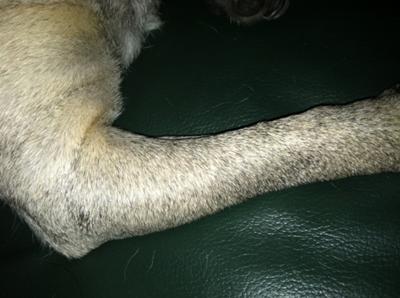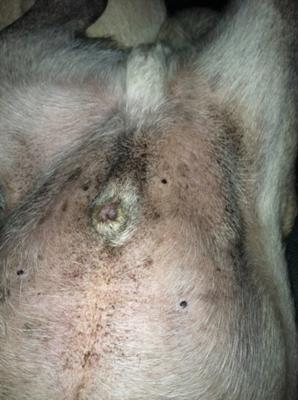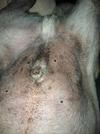Darkened Skin and Excessive Licking of Paws
by Daisy
(Clermont, FL)

Legs used to be tan with no black
Reader Question: How To Stop Canines From Licking Their Paws?
I have two male fawn pugs (ages 8 and 10, not related) with excessive paw licking. Their skin has turned grayish/black. You can see in one of the photos below of one of their paws that the black shows through a paw that used to be all tan/fawn in color. Their vet has given them two steroid injections and the licking stopped for about 3 to 4 weeks the first time and less time after the second injection. The licking started back up gradually.
During that time, their skin returned to their light/pinkish color it used to be. Their vet doesn't want to give them any more steroid injections and recommends taking them to a skin doctor, which I was told is going to be very pricey, especially since the cost is multiplied by two. Is it possible that this could be a simple allergy to food that I could troubleshoot myself? Any ideas?
Veterinarian Answers Reader Question Regarding Excessive Licking Of Paws and Darkened Skin
Hello,
Yes, an allergy of some sort is certainly possible, and there are a few things you can try at home before making an appointment with the veterinary dermatologist. In my experience, itchy feet (especially if the problem is seasonal) most often occurs as a result of an environmental
I’ve had the best luck diagnosing food allergies using an eight to twelve week food trial during which the dogs eat nothing but a hydrolyzed diet like Purina HA or Hill’s z/d (your current vet can prescribe one of these foods). You need to feed this and only this (no treats, flavored medications, etc.) during the entire food trial. If your dogs’ symptoms disappear or at least get much better, you have diagnosed them with a food allergy. Then you can decide whether you want to continue feeding that diet or gradually reintroduce ingredients until you find the one(s) she reacts to so you can avoid them in the future.
If neither of these approaches works, it’s definitely time to make an appointment with the veterinary dermatologist.
Best of luck,
Jennifer Coates, DVM
Join in and write your own page! It's easy to do. How? Simply click here to return to Skin.



